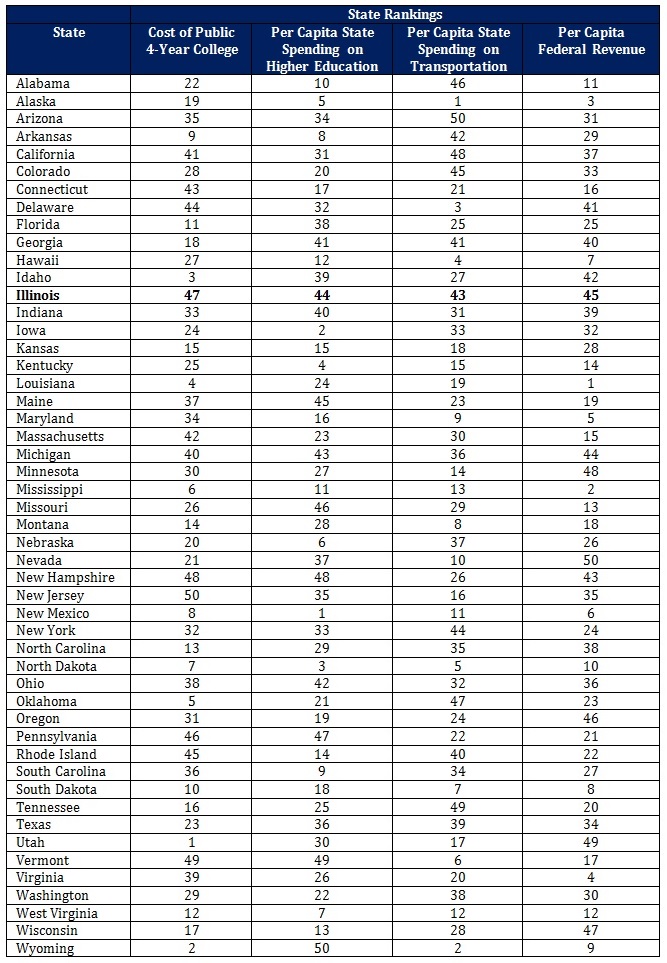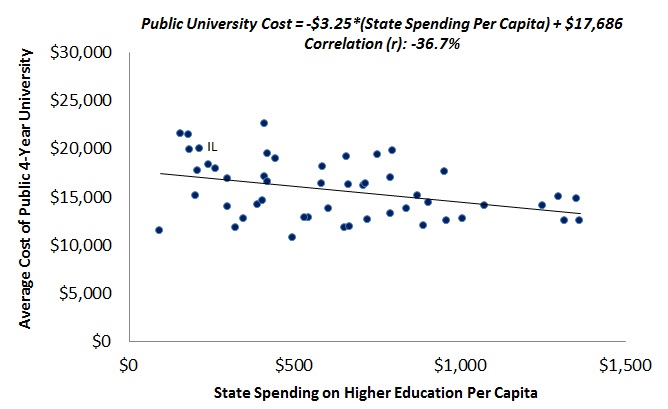Two weeks ago, I wrote about how more infrastructure investment would kickstart the Illinois economy. Transportation infrastructure investment is one government spending item that conclusively boosts employment and reduces costs over the long run. Investment in human capital– in education and skills– is another.
Unfortunately, data from the Social Science Research Council’s Measure of America (scroll down for full data) illustrate how little the State of Illinois spends on transportation infrastructure and higher education compared to the rest of the country.
According to the data, state spending on higher education per capita is $217 in Illinois. This falls significantly below most neighboring states, including Wisconsin ($842), Kentucky ($1,300), and Iowa ($1,354). Among all 50 U.S. states, Illinois ranks 44th in higher education spending per capita.
The cost to attend a 4-year public college in Illinois, on the other hand, is one of the highest in the country. With an average annual price tag of $20,254, Illinois ranks 47th out of all 50 states in cheapest public universities. Wisconsin, Kentucky, and Iowa “only” cost between $13,819 and $15,002 per year.
And yes, in case you were wondering, there is a correlation. As state funding drops within a state, college tuition goes up. The across-state data from Measure of America show that, on average, every $100 increase in higher education spending per capita tends to reduce the annual cost of attendance for students by $325. Slashing higher education spending shifts the costs to poor college students and results in higher student debt.

The story is essentially the same for state spending on transportation. At $305 per capita, Illinois ranks 43rd in transportation spending per capita and below every bordering state. Indiana spends $375 per capita, Kentucky spends $505.
As we at ILEPI have explained before, this is actually in large part because Illinois is a “donor state.” Illinois has a high-wage economy, and workers pay more in federal income taxes as a result. Meanwhile, Illinois receives far less support from the federal government compared to other states. As a result, the State of Illinois has fewer resources than neighboring states to spend on transportation infrastructure or on higher education.
The Measure of America data indicate that Illinois ranks 45th in federal revenue per capita among all 50 states. At $6,433 in federal revenue per capita, Illinois falls significantly below states like Iowa ($7,344) and Missouri ($8,952). Another recent ILEPI estimate suggests that Illinois ranks 46th in federal funding. Because Illinois cannot depend on the federal government for support, it is forced to either raise other taxes to make up the shortfall or spend less than neighboring states. The fact that the federal government covers 53.4% of Missouri’s spending on highways but only accounts for 27.7% of Illinois’ spending on highways is one of the main reasons why the motor fuel tax is higher in Illinois.
Illinois spends less on higher education and transportation than nearly every other state. To improve the state economy and create thousands of jobs, the state must increase investments in physical capital and human capital.


Frank Manzo IV is the Policy Director of the Illinois Economic Policy Institute (ILEPI). Visit ILEPI at www.illinoisepi.org or follow ILEPI on Twitter @illinoisEPI. This post is part of the “Frankonomics” series.
